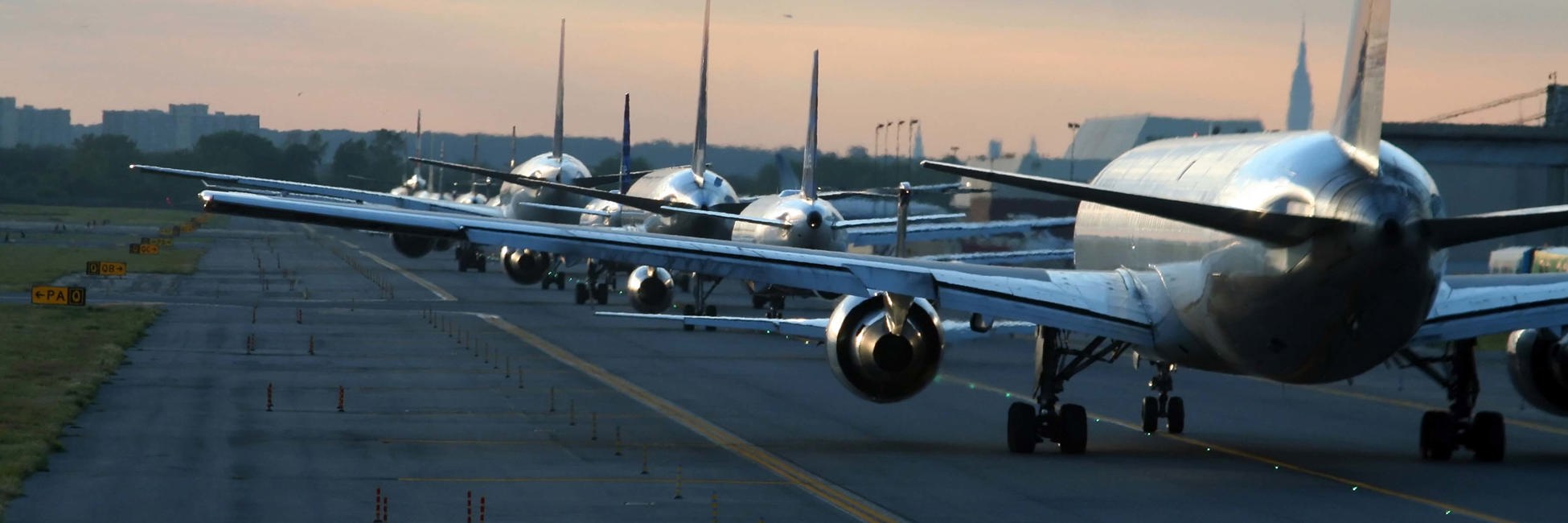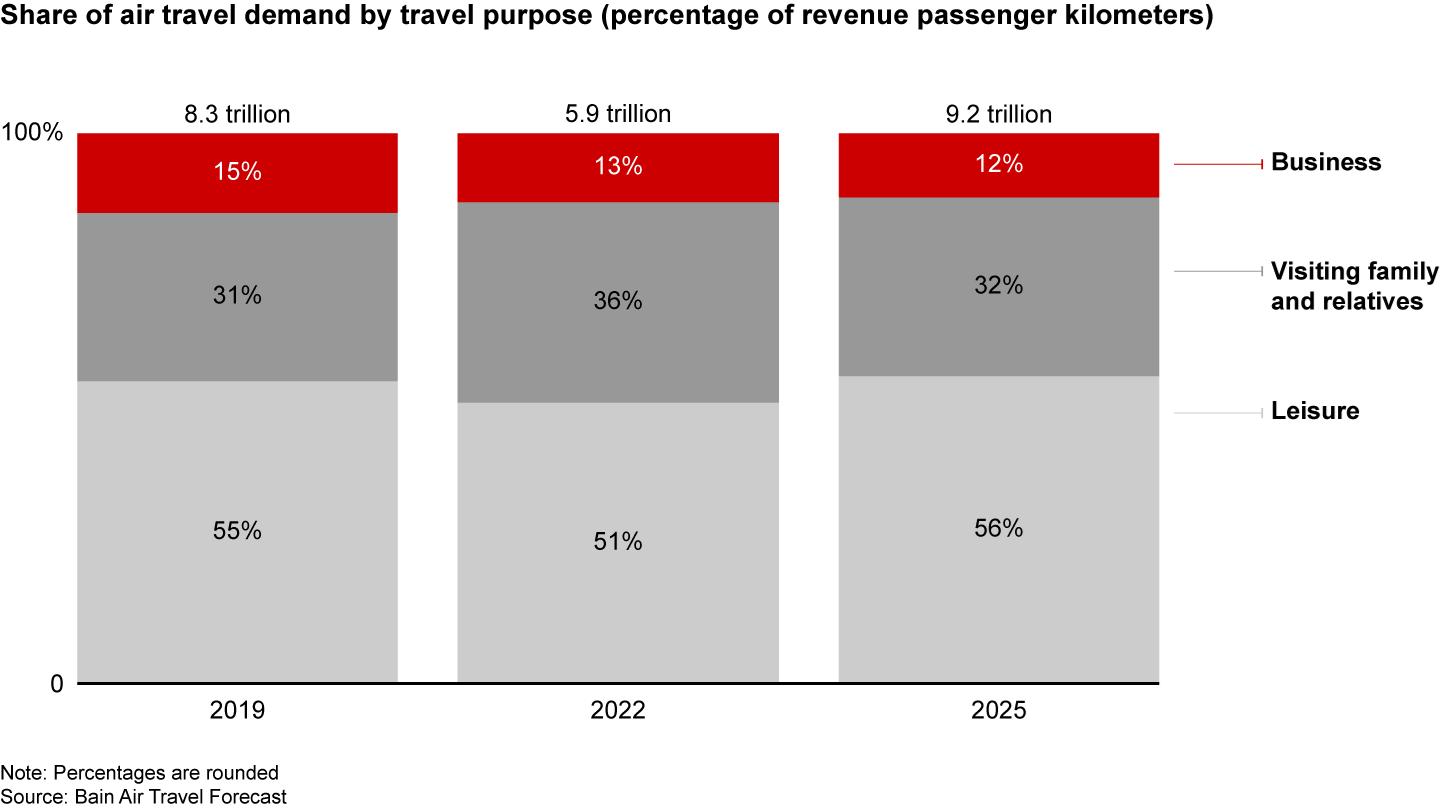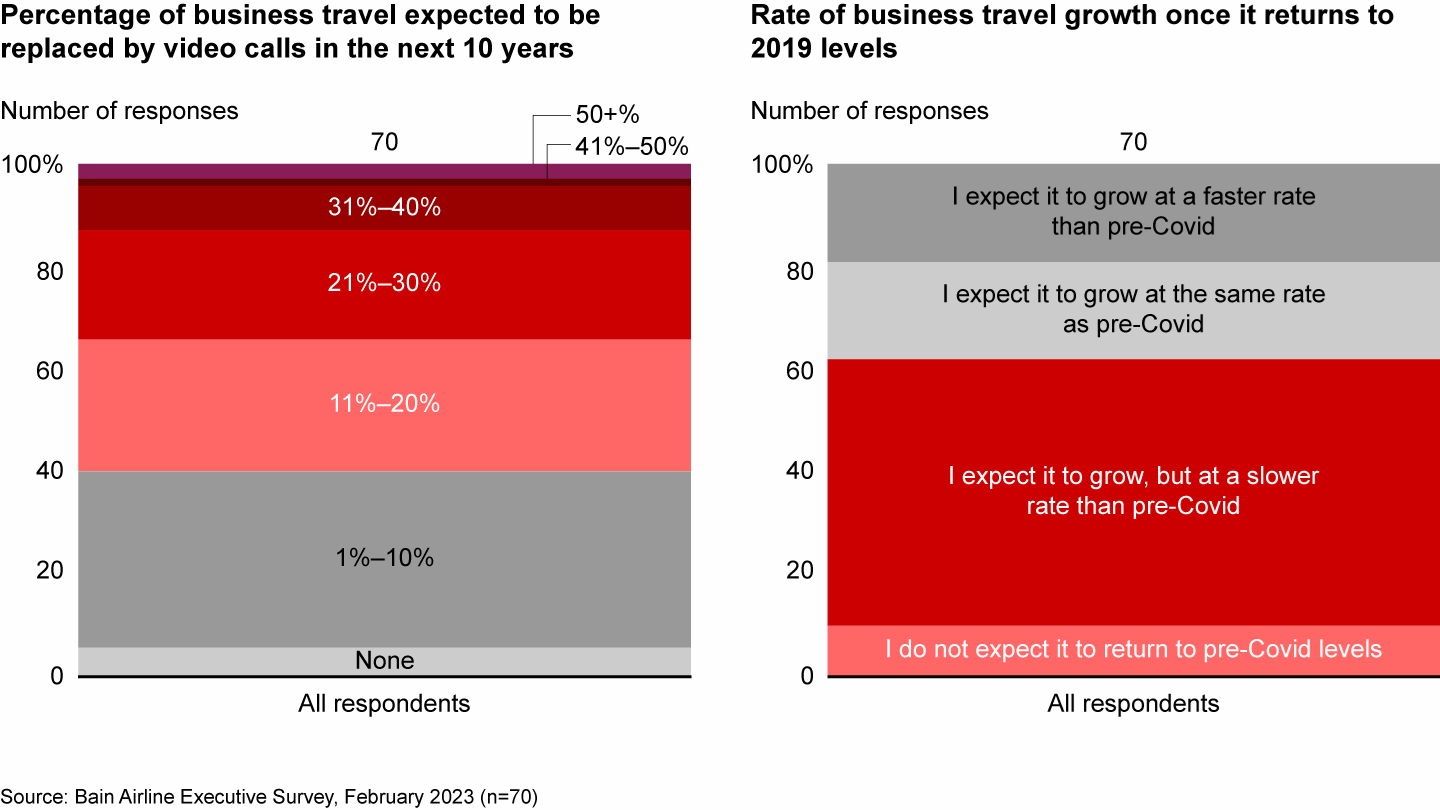Brief

Резюме
- Business travel remains 25% to 30% below prepandemic levels, shifting the airline passenger mix toward lower-profit leisure travel.
- Sustainability regulations and the cost of reducing carbon emissions will start to affect airline and supplier profits as soon as 2026.
- Labor shortages and inflation will continue to raise costs and heighten the war for talent, especially for pilots, engineers, and other skilled labor.
Commercial aviation has nearly recovered from the precipitous drop in air travel during the pandemic, but the industry is headed for more turbulence. Structural changes including higher costs, a decline in business travel, and investments in sustainable technologies will lead to a systemic decline in profitability in the coming decade.
The growing pressure on profits will limit the industry’s ability to invest at a pivotal moment. Airlines and governments have pledged to decarbonize air travel by 2050, but the technologies needed to achieve that goal, such as sustainable aviation fuels and electric propulsion, will cost trillions of dollars. An added challenge is restarting the industry’s innovation engine in the wake of the pandemic, which prompted aircraft manufacturers to put new models on hold. Suppliers have had limited ability over the past few years to invest in fuel-efficient technologies and design given the financial impact of Covid-19 and delayed introductions of new aircraft models.
At the same time, technology advancements in alternative fuels, electric propulsion, advanced air mobility, and novel airframe design increase the risk of business model disruption. In the coming years, these and other advances will start to transform an aerospace industry accustomed to far more gradual change. To keep pace, leading aerospace companies will move quickly to improve productivity, scale the business, and generate the capital needed to invest in new technologies.
Profit margin squeeze
Four major trends are increasing pressure on profitability across all sectors of commercial aviation (see Figure 1). On a macroeconomic level, higher rates of inflation and labor shortages are raising costs and undercutting performance. A second powerful force is the global adoption of video conferencing software, which has sharply reduced business travel and increased the proportion of leisure travelers who are more price sensitive (see Figure 2). Third, airlines’ growing use of aftermarket service contracts based on risk-sharing and per-flight-hour charges may undermine the performance of original equipment manufacturers (OEMs). Finally, investments to lower carbon emissions and increase air travel sustainability will likely raise costs substantially over the long term.
Lower profitability will squeeze the entire aerospace value chain
Business travel will become a smaller share of the overall passenger mix


Airlines
Low-cost carriers (LCCs) have played a key role in fare moderation and air travel growth, especially in emerging markets. The market share of LCCs in 2019 was 22.6%, up from 15.9% in 2010. LCCs’ share of the narrowbody aircraft order book rose to 43% in the same period from 30%. The growth of LCCs in the US over the past two decades has pushed airfares down 3% while revenue passenger kilometers (RPKs) grew by 5%.
In the short term, LCC profitability could benefit from above-average demand for popular leisure routes for which seat availability is still limited, and pent-up postpandemic travel. However, in the long term, competition by LCCs for route share will continue to put pressure on all airfares. In addition, the decline in business travel due to video conferencing and commitments by corporations to achieve net-zero emissions will shift a larger proportion of air travel to low-cost carriers.

Bain's Quarterly Airlines Newsletter
Subscribe to receive our airlines insights in your inbox every quarter.
Business travel remains 25% to 30% below prepandemic levels, and Bain research suggests it will stay structurally lower than the prepandemic trendline. In a recent Bain survey, airline executives estimated business travelers will take around 20% fewer trips in the coming decade, a trend that will increase the relative proportion of leisure travelers in the total mix. More than 60% said that business travel in the next 10 years will either grow more slowly than it did prior to Covid or not reach pre-Covid levels (see Figure 3).
A majority of airline executives believe that video calls will permanently reduce business travel


That could mean a seismic shift for many airlines. Until Covid, business travel represented fewer than 20% of passengers, but 40% of revenue and up to 75% of profits for full-service carriers (FSCs). While a new breed of passenger who blends leisure and business travel, enabled by remote work, has been filling some of this gap, it’s unclear how long wide-scale remote work policies as well as pent-up “revenge travel” will last.
In addition, the industry faces ongoing labor shortages and persistent inflation, which raise costs and heighten the war for talent. In the short term, this trend will favor FSCs and challenge LCCs and regional airlines. FSCs are better able to offer a premium to attract scarce talent. In the long term, however, the LCC model may prove more resilient given LCCs’ extensive cost management experience.
Finally, going green will be expensive. Our research shows government regulations to promote sustainability and rising costs to decarbonize aviation will start to affect airline profits as soon as 2026, especially in Europe and in the US.
OEMs
OEMs developed their business cases for major aircraft programs long before Covid. Now, their underlying assumptions are out of sync with an environment of persistent inflation, extreme swings in operational demand, shortages of skilled labor, and supply constraints for key aerospace materials.
In addition, the long backlog for new aircraft deliveries has worsened the impact of inflation since OEMs have used up lower-cost parts and materials and are now purchasing them at higher prices. As suppliers battle to win market share, their ambitious production rates coupled with supply chain stress have forced many to make price concessions to customers. Meanwhile, the increase in fixed-price, power-by-the-hour service contracts has transferred cost risk to the OEMs. Pressure on costs will rise as LCCs increase their market share and demand competitive pricing on equipment and turnkey maintenance contracts.
Suppliers and service providers
The greatest squeeze on commercial aerospace profits will hit suppliers and aftermarket services providers. Midtier suppliers in particular have suffered a series of unexpected developments. They include the grounding of Boeing’s 737 MAX model, plunging pandemic-era demand, surging inflation, labor and materials shortages, supply chain bottlenecks, and customer pressure to trim their prices and meet steep production ramp-ups for existing and future aircraft models.
And there are more challenges on the horizon. As airlines step up the pace on replacing aging narrowbody aircraft, their fleets will be younger and less maintenance intensive. Also, the increased availability of parts derived from aircraft that have been scrapped (used serviceable material) will reduce demand for new spare parts on legacy aircraft. That in turn will force suppliers to scale back production lines for equipment on those aircraft. Over the long term, aftermarket service providers will face increased competition from OEMs offering airlines power-by-the-hour contracts.
Potential for disruption
As macroeconomic and market forces push costs up and profit pool growth slows, airframe manufacturers, engine makers, and suppliers will compete even more intensely for a larger share of the profit pool. For example, airlines facing higher costs and a larger proportion of price-sensitive leisure passengers will put pressure on equipment makers and maintenance companies to lower prices. Airframe manufacturers will then target higher-profit aftermarket services to compensate for upfront equipment discounts and generate much-needed reinvestment capital.
Engine and system OEMs will strive to reduce their costs but will face challenges given supply chain strains and accelerated delivery schedules for a decade’s worth of backlogged orders, delayed in part by the pandemic. To meet demand, suppliers may need to pay a premium to secure labor and parts. Suppliers making subsystems and components will likely continue to consolidate to increase their scale and enhance their bargaining power with Tier-1 suppliers and OEMs.
Competitive pressure will further delay investments to improve fuel efficiency in existing fossil-fuel-based aircraft just as regulatory pressure to reduce emissions grows. Rolls-Royce has spent a decade designing its next-generation UltraFan engine, which promises to deliver efficiency gains of 10% or more compared with most large aerospace engines in service. But the timing to launch it in any new aircraft keeps sliding out further into the future. A slower pace of investment by the industry is likely to encourage innovation by start-ups and others working on small electric aircraft, hybrid-electric propulsion, and fuel-efficient blended-wing-body aircraft. Eight-year-old Israeli start-up Eviation already has more than $4 billion in orders for its all-electric aircraft targeting flights of 150–250 miles with up to nine passengers.
An industry that faces a step-change in technology while hampered by high costs and limited investment capacity is ripe for disruption. New entrants may also come from adjacent industries. The use of artificial intelligence, autonomy, and nontraditional sources of propulsion is advancing rapidly in other transport sectors, including automotive and space. Breakthroughs in these industries could accelerate the use of novel technologies in commercial aerospace. As a result, commercial aerospace companies will continue to attract investment, despite growing pressure on profits.
The path forward for commercial aerospace
Management teams that successfully adjust their strategies in five key areas will emerge as winners in an era of lower profitability.
Improve productivity. Companies must find ways to do more with less as they grapple with talent shortages and higher costs. Boosting productivity can provide a strong competitive advantage in design, manufacturing, and sourcing. For example, engineering is the lifeblood of innovation for aerospace companies, but a recent Bain study shows only 50% of an engineer’s time at aerospace and defense companies is spent on active engineering work. Companies that deploy scarce talent to the highest-value activities while bringing in greater automation and process improvements will ensure they have the capital to invest in the future.
Build scale. Consolidation over the past two decades has left only a handful of airframe manufacturers, engine OEMs, and “super Tier-1” suppliers standing. This trend is likely to continue further down the value chain, deep in the supply base where the whipsaw effect of sharp production rate swings has taken a toll. Simply put, scale and market leadership are vital attributes when customers demand both innovation and lower cost. HEICO’s recent acquisition of Wencor, combining two of the leading suppliers of OEM alternative parts and repairs, highlights the consolidation trend.
Grow with discipline. Not all growth is created equal. Many suppliers and maintenance, repair, and operations providers are accepting lower-margin contracts to fuel growth or preserve market share. That strategy is likely to erode long-term profitability, especially when contracts involve new technologies and risk-sharing arrangements. Winning companies get sales incentives right, are disciplined with discounts, invest in underwriting capabilities, and walk away from contracts when the terms don’t make sense.
Make fewer, smarter bets. With so many new technologies and sustainability pathways on the horizon, leadership teams face difficult investment choices. Doing a little of everything spreads limited investment capital too thin, while only focusing on one or two new technologies runs the risk of swinging big but striking out. Successful companies use a more flexible, portfolio approach, segmenting decisions into no-regret moves, options and hedges, and big bets. Importantly, these leadership teams monitor technological signposts and allocate capital in an agile and more disciplined way.
Partner. As the recent rise of generative artificial intelligence has shown, venture capital investments can lead to remarkable innovation in start-ups and niche companies. To tap into new technological capabilities like these, aerospace leaders will seek collaboration. In a period when profits are constrained and investment capital is in shorter supply, becoming an attractive partner for highly innovative companies can help accelerate innovation.
Despite the change and uncertainty ahead, new technologies will create many opportunities for commercial aerospace companies, including the chance to be a first mover. Executive teams that understand the forces transforming the industry and that take bold steps to lead change are likely to develop a strong competitive advantage.